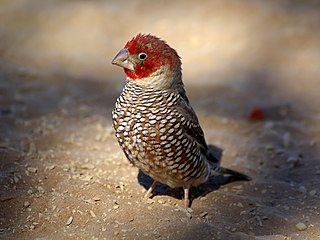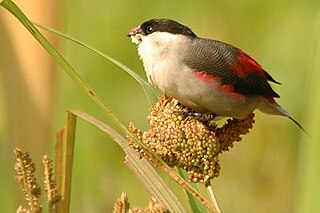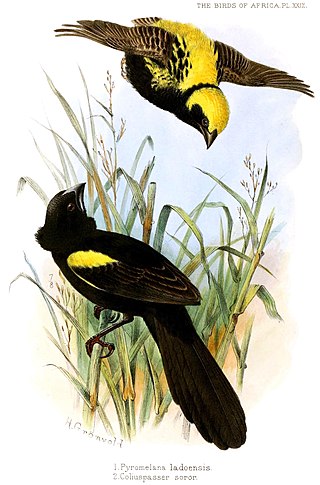
The wagtails, longclaws, and pipits are a family, Motacillidae, of small passerine birds with medium to long tails. Around 70 species occur in five genera. The longclaws are entirely restricted to the Afrotropics, and the wagtails are predominantly found in Europe, Africa, and Asia, with two species migrating and breeding in Alaska. The pipits have the most cosmopolitan distribution, being found mostly in the Old World, but occurring also in the Americas and oceanic islands such as New Zealand and the Falklands. Two African species, the yellow-breasted pipit and Sharpe's longclaw, are sometimes placed in a separate seventh genus, Hemimacronyx, which is closely related to the longclaws.

The Cape longclaw or orange-throated longclaw is a passerine bird in the family Motacillidae, which comprises the longclaws, pipits and wagtails. It occurs in Southern Africa in Zimbabwe and southern and eastern South Africa. This species is found in coastal and mountain grassland, often near water.

Sharpe's longclaw is a passerine bird in the longclaw family Motacillidae, which also includes the pipits and wagtails. It is endemic to Kenya.

The sabrewings are relatively large Neotropical hummingbirds that form the genus Campylopterus. They are species of the understory and edges of forests, mostly in mountains, and often near streams. The female Sabrewing lays its two white eggs in a relatively large cup nest on a low horizontal branch, usually over a stream.

Setophaga is a genus of birds of the New World warbler family Parulidae. It contains at least 34 species. The males in breeding plumage are often highly colorful. The Setophaga warblers are an example of adaptive radiation with the various species using different feeding techniques and often feeding in different parts of the same tree.

The yellow-faced grassquit is a passerine bird in the tanager family Thraupidae and is the only member of the genus Tiaris. It is native to the Central America, South America, and the Caribbean.

Petroica is a genus of Australasian robins, named for their red and pink markings. They are not closely related to the European robins nor the American robins.

The red-headed finch is a common species of estrildid finch found in Africa. It has an estimated global extent of occurrence of 1,600,000 km2. It is found in Angola, Botswana, Lesotho, Namibia, South Africa and Zimbabwe.

Amadina is a genus of estrildid finches that are found in Africa.

The fawn-breasted tanager is a species of tanager with a blue head and yellow breast. It occurs in the Andes of northwestern Argentina, Bolivia, Colombia, Ecuador, Peru and Venezuela, as well as in the highlands of northeastern Argentina, south Brazil, Paraguay and Uruguay.

The white-rumped seedeater is a species of finch in the family Fringillidae. It is found throughout the Sahel and the eastern part of the Sudan region. Its natural habitat is dry savanna. It is known elsewhere and in aviculture as the grey singing finch.
Reichard's seedeater is a species of finch in the family Fringillidae. It is native to the miombo savanna . It is named after the German explorer Paul Reichard.

Tigrisoma is a genus of herons in the family Ardeidae.

Estrilda is a genus of estrildid finch in the family Estrildidae.

Euplectes is a genus of passerine bird in the weaver family, Ploceidae, that contains the bishops and widowbirds. They are all native to Africa south of the Sahara. It is believed that all birds in the genus are probably polygynous.

Fluvicola is a genus of birds in the tyrant flycatcher family Tyrannidae.

The Pangani longclaw is a species of bird in the family Motacillidae, which includes the pipits and wagtails. It is found in Tanzania, Kenya and Somalia. The bird's natural habitats are dry savanna and subtropical or tropical dry lowland grassland.

Sporophila is a genus of Neotropical birds in the tanager family Thraupidae. The genus now includes the six seed finches that were previously placed in the genus Oryzoborus.

Dendroplex is a genus of birds in the woodcreeper subfamily Dendrocolaptinae. It was long merged into Xiphorhynchus, but its distinctness has now been established.

Crithagra is a genus of small passerine birds in the finch family (Fringillidae). They live in Africa and Arabia.

























